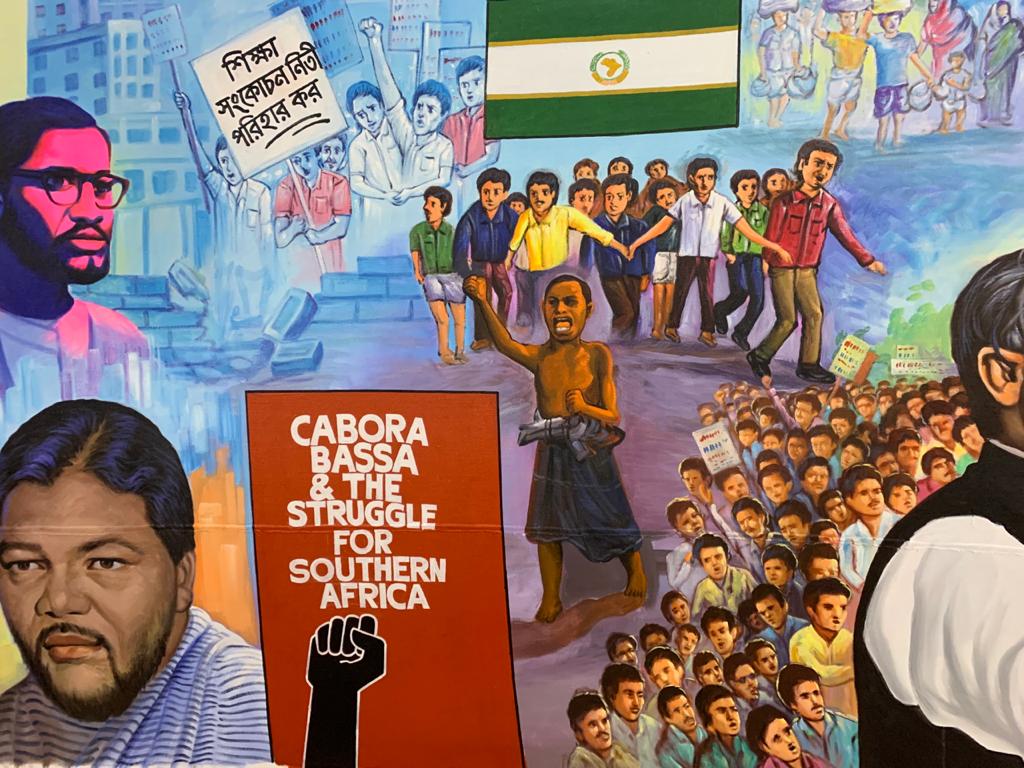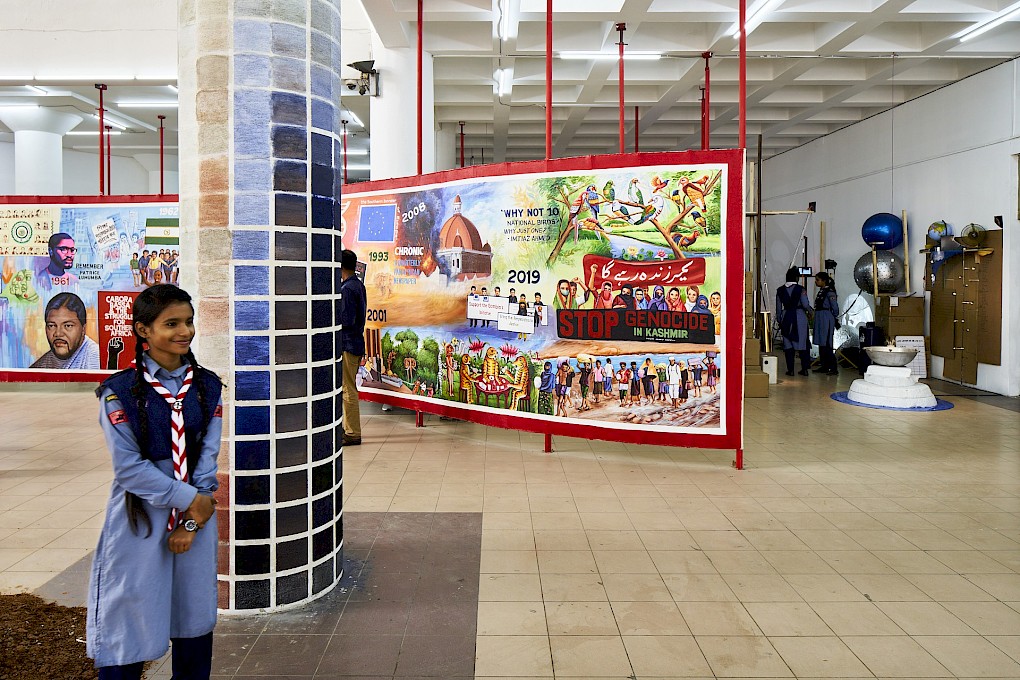Geographies of Imagination

Research and Installation project 07.02.–15.02.2020
At Dhaka Art Summit 2020, Bangladesh
Geographies of Imagination is a growing research and exhibition project that manifests itself as a cartographic time-line, a performative process of un-mapping the geography of power and a space of discourse. The project is an attempt to rethink, reconfigure and pervert history-at-large and cartographic histories in particular. Each iteration of Geographies of Imagination assumes different point of departure, situates itself within another real or fictional geography, and thus brings about differing research processes and outcomes.
Its second rendition, developed in the context of the 2020 Dhaka Art Summit in Bangladesch, Geographies of Imagination has two vantage points. For its first point, it takes the partition of 85 million people throughout Bengal in 1905 implemented by the British Raj in an effort to "reorganise" but ultimately to divide and rule, by cutting through the middle of the Bengali-speaking "nation". Its second point is the Congo Conference hosted in Berlin in 1884, a moment in which fourteen Western "great powers" partitioned the African continent amongst themselves for their geopolitical, exploitative economic and colonial agendas and fantasies, thereby re-imagining the cartography of the African continent irrespective of the peoples, cultures, and languages of Africans.
This iteration of Geographies of Imagination was developed through a wide range of interviews with academics and researchers from various disciplines, artists, curators, and researchers based predominantly in Dhaka in collaboration with the Samdani Art Foundation and Goethe Institut, Bangladesh. The timeline recurs with dates held in Bengali, Ethiopian and Gregorian calendars, to emphasise how the system of time itself is situated and subject to different representations and variations. The visualisation is the outcome of a close dialogue with the Dhaka based Jothashilpa collective, working with master cinema banner painter Ustad Mohammad Shoaib, artist and researcher Shawon Akand, and artists Sharmin Afroz Laboni and Alia Kamal. It manifests as a 36m long and 3m high seamless painting – featuring both images and text – on jute textile in the aesthetic language of Bangladeshi cinema banner painting, making it de-facto one of the largest cinema-banner paintings ever realized. This architectural and narrative piece acts as an infrastructure to the DAS2020 main exhibition hall, dividing its different spaces through an amoeba-like shaped form.



This incomplete timeline winding across the South Plaza of DAS features significant socio-political and cultural movements that pre-defined identities and nationhood, as well as rebellions and revolts against colonial rule, such as those that forged forms of resistance that planted seeds for future emancipation across different geographies. This includes how the socio-political movements on the African continent informed resistance movements in Asia and vice-versa. One such example is the Indigo revolt (ca. 1859–1862), through which Bengali farmers organised against plantation owners who severely undercut the price of indigo, thereby forcing farmers to sell their products at a price far below their own cost of production. We trace lines that move across centuries and oceans, looking for instance at the Anlu revolt (1958–1961), brought forth by Kom women in western Cameroon against the British administrative interference in agriculture (which was a female domain) and the alleged plan by the ruling political party to sell Kom land to Nigerian Igbos. The rebellion, which was crucial for the victory of the democratic party at the time of independence from colonial rule, had at its core women stripping naked in front of men as a weapon of rebellion – a practice implemented by other groups like the Takembeng.
We weave in connections between conferences and alliances that have strengthened positions of emancipation in contexts facing similar conditions of oppression. Novel forms of trans-national solidarity, from the first Pan-African conference held in London (in 1900), through the Baku Congress (1920), the Asian Relations Conference (1947), the Bandung Conference or African-Asian Conference in Indonesia (1955) and to the foundation of the Movement of the Non-Aligned that followed in Belgrade (1961–ongoing), among others. We pause on movements for independence and listen to fragments of charismatic political speeches bearing witness to new proposals and ideas with regards to justice, and sovereignty. But we also look at populistic and nationalistic speeches of more recent political leaders, at new border control monitoring systems, visa regulations, economic trades, and import and export of labour forces, that create and multiply invisible frontiers and partitions, and at how recent technological developments have facilitated novel forms of cartographic scarification and forced constructions of spaces and communities.
In a time when in Cameroon the lines of citizenship are drawn upon remnants of colonial language structures between Anglophones and Francophones, in a time when the Citizen Amendment Act and national register of citizens want to make Indian Muslims foreigners in their own country, in a time when black Africans are kicked out of South Africa in several waves of xenophobic attacks, in a time when the Rohingyas are openly persecuted in Myanmar, we must reconsider the powers that make geography be.
This iteration of Geographies of Imagination was developed through a wide range of interviews with academics and researchers from various disciplines, artists, curators, and researchers based predominantly in Dhaka in collaboration with the Samdani Art Foundation and Goethe Institut, Bangladesh. The timeline recurs with dates held in Bengali, Ethiopian and Gregorian calendars, to emphasise how the system of time itself is situated and subject to different representations and variations. The visualisation is the outcome of a close dialogue with the Dhaka based Jothashilpa collective, working with master cinema banner painter Ustad Mohammad Shoaib, artist and researcher Shawon Akand, and artists Sharmin Afroz Laboni and Alia Kamal.
RESEARCH Antonia Alampi, Bonaventure S.B. Ndikung, Olani Ewunnet and Shawon Akand.
VISUALIZation Jothashilpa
PRODUCTION MANAGEMENT Hamayet Himu
PAINTERS Mohammad Shoaib, Didarul DipuS., M. Sumon, Abdur Rob, Mohammad Yusuf, Rafiqul Islam Shafikul, Md. Rahim Badir, Mohammad Iqbal, Mohammad Dulal, Aftab Alam, Mohammad Javed, Md. Selim
Dhaka Art Summit 2020 "Seismic Movements"
CURATOR Diana Campbell Betancourt
ASSISTANT CURATOR Ruxmini Reckvana Q Choudhury
RESEARCH ASSISTANCE Eshan Kumer Maitra and Taiara Farhana Tareque
Thanks to the many conversations had with Dhaka-based artists, researchers, historians, professors, and designers, including Sadya Mizan, Yasmin Jahan Nupur, Tayeba Begum Lipi, Mahbubur Rahman, Emran Sohel, Jewel A Rob and Sanjid Mahmud, Reetu Sattar, Mustafa Zaman, Rezaur Rahman, Tanzim Wahab, Kabir Ahmed Masum, Nurur Khan, Amena Khatun, Sanjoy Chakraborty, Shayer Gofur, Nazrul Islam, Wakilur Rahman, Shishir Bhattacharjee, Huraera Jabeen, Imtiaz Ahmed, Marina Tabassum, Parsa Sanjana Sajid and Sayeed Ferdous.
Support Goethe-Institut Bangladesh and Samdani Art Foundation

